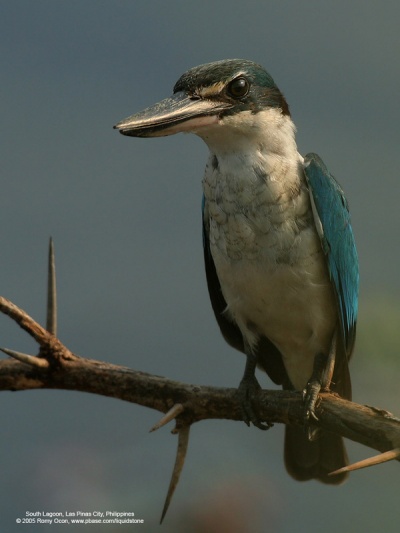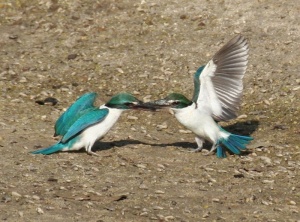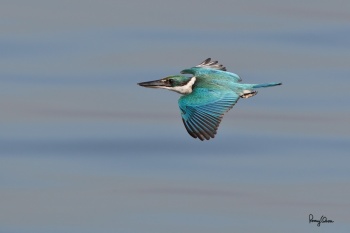(taxonomy (split into 6 species by Clements)) |
(Picture of Fiji subspecies. References updated) |
||
| Line 36: | Line 36: | ||
**''T.c.brachyurus'': Reef Islands (Fenualoa and Lomlon) | **''T.c.brachyurus'': Reef Islands (Fenualoa and Lomlon) | ||
**''T.c.vicina'': Duff Group (eastern [[Solomon Islands]]) | **''T.c.vicina'': Duff Group (eastern [[Solomon Islands]]) | ||
| + | [[Image:819 Kingfisher Collared 01a Todiramphus chloris eximius FIJI - Copy.jpg|thumb|350px|right|Subspecies ''eximius'' <br />Photo by {{user|peterday|peterday}}<br />Kadavu Island, [[Fiji]], September 2015]] | ||
**''T.c.ornatus'': Eastern [[Solomon Islands]] (Santa Cruz and Tinakula) | **''T.c.ornatus'': Eastern [[Solomon Islands]] (Santa Cruz and Tinakula) | ||
**''T.c.utupuae'': Utupua Island (Santa Cruz Group in eastern [[Solomon Islands]]) | **''T.c.utupuae'': Utupua Island (Santa Cruz Group in eastern [[Solomon Islands]]) | ||
| Line 75: | Line 76: | ||
**''T.c.bennetti'': Nissan Island (eastern [[Papua New Guinea]]) | **''T.c.bennetti'': Nissan Island (eastern [[Papua New Guinea]]) | ||
**''T.c.tristrami'': New Britain (Bismarck Archipelago) | **''T.c.tristrami'': New Britain (Bismarck Archipelago) | ||
| − | **''T.c.alberti'': Buka, Bougainville and [[Solomon Islands]] (east to Guadalcanal) | + | **''T.c.alberti'': Buka, Bougainville and [[Solomon Islands]] (east to Guadalcanal) |
| + | |||
The subspecies ''regina'', ''eximius'' and ''vitiensis'' are sometimes placed within [[Sacred Kingfisher]]. | The subspecies ''regina'', ''eximius'' and ''vitiensis'' are sometimes placed within [[Sacred Kingfisher]]. | ||
| Line 86: | Line 88: | ||
It nests in holes. The clutch consists of 2-7 round whitish eggs which are incubated by both parents. The young fledge about 44 days after hatching. | It nests in holes. The clutch consists of 2-7 round whitish eggs which are incubated by both parents. The young fledge about 44 days after hatching. | ||
==References== | ==References== | ||
| − | #{{Ref- | + | #{{Ref-Clements6thAug15}} |
{{ref}} | {{ref}} | ||
Revision as of 19:27, 26 September 2015
- Todiramphus chloris
Todirhamphus chloris, Halcyon chloris
Identification
22-29 cm
- Blue-green upperparts
- White or buff underparts
- White neck collar
- Black eye stripe
- Black bill
- Pale yellow lower mandible
Female: more green
Subspecies vary with white or buff eyestripes, white spot between bill and eye.
Distribution
Taxonomy
Was previously Halcyon chloris. The Sibley-Monroe spelling of the scientific name (Todirhamphus chloris) is incorrect. Clements and Howard & Moore both use Todiramphus chloris. More details in this discussion.
Subspecies
This is a polytypic species consisting of 50+ subspecies which are now split into six species by Clements[1]. However other authorities don't yet recognized this split and the Opus follows.
- Pacific Kingfisher (Todiramphus sacer)
- T.c.torresianus: Torres Group (Toga, Loh and Hiu)
- T.c.santoensis: Banks Group to Espíritu Santo and Malo (northern Vanuatu)
- T.c.juliae: Northern and central Vanuatu (Maewo and Aoba islands to Efate)
- T.c.erromangae: Erromango Island (southern Vanuatu)
- T.c.tannensis: Tanna Island (southern Vanuatu)
- T.c.sacer: Tonga
- T.c.pealei: Tutuila Island (American Samoa)
- T.c.manuae: American Samoa (Ofu, Olosega and Tau)
- T.c.mala: Malaita (eastern [Solomon Islands]])
- T.c.sororum: Southern Solomon Islands (Malaupaina and Malaulalo)
- T.c.pavuvu: Pavuvu Island (Russel Group in central Solomon Islands)
- T.c.solomonis: Solomon Islands (Uki Ni Masi, Makira and Santa Anna)
- T.c.amoenus: Solomon Islands (Rennell and Bellona)
- T.c.brachyurus: Reef Islands (Fenualoa and Lomlon)
- T.c.vicina: Duff Group (eastern Solomon Islands)
- T.c.ornatus: Eastern Solomon Islands (Santa Cruz and Tinakula)
- T.c.utupuae: Utupua Island (Santa Cruz Group in eastern Solomon Islands)
- T.c.melanodera: Vanikolo Island (Santa Cruz Group in eastern Solomon Islands)
- T.c.marinus: Lau Archipelago (eastern Fiji)
- T.c. vitiensis: Fiji (Ngau, Ovalau, Koro, Viti Levu, Vanua Levu and Taveuni)
- T.c. eximius: Fiji (Kandavu, Ono and Vanua Kula)
- T.c. regina:Futuna (Wallis and Futuna, central Polynesia)
- Colonist Kingfisher (Todiramphus colonus)
- T.c.colonus: Islands off south-eastern Papua New Guinea and Louisiade Archipelago
- Torresian Kingfisher (Todiramphus sordidus)
- T.c.pilbara: Western Australia (Exmouth Gulf to mouth of Turner River)
- T.c.sordidus: Southern New Guinea, Aru Islands and coastal northern Australia
- T.c.colcloughi: Central Queensland coast to north-eastern New South Wales
- Collared Kingfisher (Todiramphus chloris)
- T.c.abyssinicus: West coast of Red Sea to head of Gulf of Aden
- T.c.kalbaensis: South coast of Arabian Peninsula to extreme north-western Oman
- T.c.humii: North-western India to Malay Peninsula, Thailand, Myanmar, Mergui Archaepelago
- T.c.vidali: Peninsular India (Ratnagiri District)
- T.c.armstrongi: Southern Thailand and Myanmar
- T.c.davisoni: Andaman Islands and Cocos Islands (Indian Ocean)
- T.c.occipitalis: Nicobar Islands
- T.c.chloropterus: Islands off western Sumatra (except Enggano)
- T.c.azelus: Enggano Island (off south-western [Sumatra]])
- T.c.palmeri: Java, Bali and adjacent islands in Java Sea
- T.c.laubmannianus: Southern Sumatra, Borneo and adjacent islands
- T.c.collaris: Philippines, Sulu Archipelago and Palawan
- T.c.chloris: Sulawesi to north-western New Guinea and Lesser Sundas
- T.c.teraokai: Palau Islands (western Caroline Islands)
- Mariana Kingfisher (Todiramphus albicilla)
- T.c.owstoni: Northern Mariana Islands (Asuncion, Pagan, Almagan and Agrihan)
- T.c.albicilla: Southern Mariana Islands (Saipan, Tinian and Aguiguan)
- T.c.orii: Rota Island (southern Mariana Islands)
- Melanesian Kingfisher (Todiramphus tristrami)
- T.c.matthiae: St. Matthias Islands (Papua New Guinea)
- T.c.stresemanni: Witu, Umboi and adjacent islands in Dampier Straits
- T.c.nusae: New Ireland (except south-west), New Hanover and Feni Islands
- T.c.novaehiberniae: New Ireland (Bismarck Archipelago)
- T.c.bennetti: Nissan Island (eastern Papua New Guinea)
- T.c.tristrami: New Britain (Bismarck Archipelago)
- T.c.alberti: Buka, Bougainville and Solomon Islands (east to Guadalcanal)
The subspecies regina, eximius and vitiensis are sometimes placed within Sacred Kingfisher.
Habitat
Coastal areas, mangrove swamps, farmland, open woodland, grassland and gardens.
Behaviour
Diet
The diet includes crabs, insects, shrimps, frogs, worms, snails, lizards and small fish.
Breeding
It nests in holes. The clutch consists of 2-7 round whitish eggs which are incubated by both parents. The young fledge about 44 days after hatching.
References
- Clements, J. F., T. S. Schulenberg, M. J. Iliff, D. Roberson, T. A. Fredericks, B. L. Sullivan, and C. L. Wood. 2015. The eBird/Clements checklist of birds of the world: v2015, with updates to August 2015. Downloaded from http://www.birds.cornell.edu/clementschecklist/download/
Recommended Citation
- BirdForum Opus contributors. (2024) Collared Kingfisher. In: BirdForum, the forum for wild birds and birding. Retrieved 25 April 2024 from https://www.birdforum.net/opus/Collared_Kingfisher
External Links







